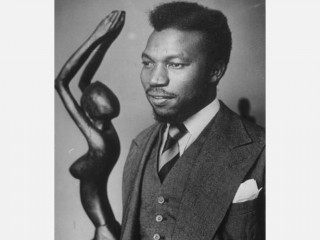
Ben Ewonwu biography
Date of birth : 1921-07-14
Date of death : -
Birthplace : Onitsha, Nigeria
Nationality : Nigerian
Category : Arts and Entertainment
Last modified : 2011-01-12
Credited as : Sculptor, ,
Benedict Chuka Ewonwu was the first Nigerian artist to win international acclaim. His sculpture and painting reflect his conviction that art must be a personal statement and not a stereotyped conformity to any particular style.
The talent of Ben Ewonwu for woodcarving was recognized early. In 1944 the Nigerian government sponsored his further study in England, and he won his diploma in fine arts at the University of London. His first major exhibition, at the Apollinaire Gallery in London in September 1950, was a popular success, and his work was applauded by art critics. In the period after Nigerian independence Ewonwu held the post of federal art adviser.
During the early period in his career Ewonwu's favorite medium was woodcarving. Although his reputation rests on his bronze and terra-cotta work, his skill at exploiting the natural grain of wood to express the desired motion of the figure remains his greatest strength. In wood he seems more introspective and not as torn by the conflicting demands of the public. This public is either European, which demands of him some expression of the traditional in his work, or African, which until recently considered European naturalism to be superior to African motifs. He maintained with considerable justification that he could change from one style to another just as he was able to create in stone, wood, or bronze.
Whatever the reason, Ewonwu produced prolifically in all styles, utilizing various materials. His terra-cotta sculptures are usually naturalistic renderings of African subjects. Among the best of these are the Head of Kofi and the Head of Koyi. The statue of Queen Elizabeth II in front of the old Federal House of Representatives in Lagos is probably his best-known public monumental statue.
A key to understanding Ewonwu's blend of the traditional and the natural and the conflict between these two is the bronze statue entitled The Awakening, outside the Nigerian Museum in Lagos. It is a female figure with an abstract body which rises in an elongated shaft from a thin base. To this Ewonwu affixed a face and hands rendered in a realistic fashion.
Ewonwu was also a painter of considerable merit. His landscapes executed in bold colors have had a wide appeal among middle-class Nigerians. By contrast, he also created a series of paintings called Africa Dances, in which he attempted to recapture the mysterious rhythm of old Africa by abandoning naturalism. He was also commissioned to do large-scale murals. The best examples of this type are those he created for the Nigerian Corporation Building in Lagos.
A short biography of Ewonwu and a discussion of contemporary Nigerian art are in Evelyn S. Brown, Africa's Contemporary Art and Artist (1966). See also Ulli Beier's two works, Art in Nigeria (1960); and Contemporary Art in Africa (1968); and Tibor Bodrogi, Art in Africa (1968).
















